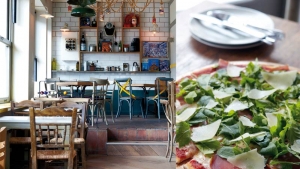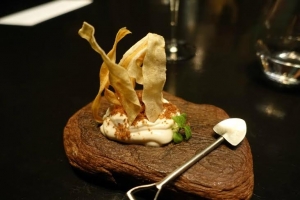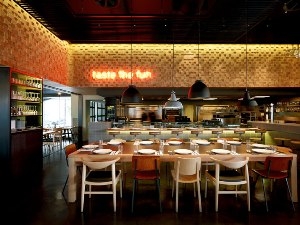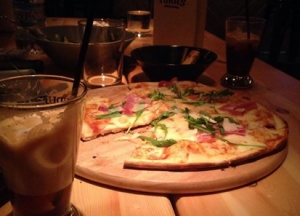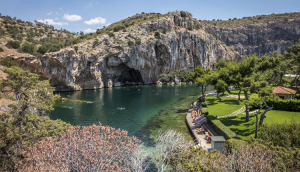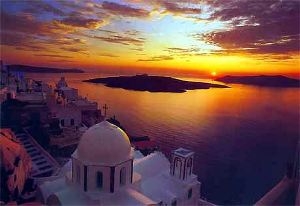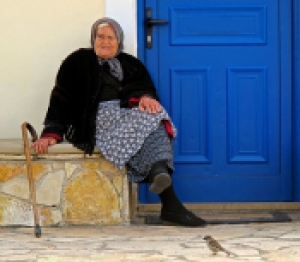SERVICES
XpatAthens
Coupepe Bake & Shake
It's cute and fun – The restaurant’s names decorates the bar made up of childrens’ toy letters onto a retro-train and is famous in the northern suburbs for its delicious pizza. From the tables of the restaurant out on the cool square of Nea Penteli, you can see the open kitchen, the refrigerator with all the goodies and the oven in which about 25 different types of pizza are made.
They are divided into three categories: Red (classic tomato sauce and mozzarella) , white or bianca (no tomato sauce) and sweet pizza (with chocolate, Oreo cookie and wild cherry, pear, cookies, almond biscuit and more.
Address: Iroon Polytechniou Square, Nea Penteli
Tel: 210 8100 040
To read more, please visit athinorama.gr
Dining Out At Athens’ Most Talked About Restaurant!
Ever since Funky Gourmet - Athens’ high temple to molecular cuisine - won its second Michelin Star last year, my husband and I had been itching to go and find out what all the fanfare was about.
Having trained at the legendary “El Bulli” in Spain (the tiny restaurant famed for producing the planet’s most audacious “haute cuisine”), we guessed that Funky Gourmet’s founding chefs Georgianna Hiliadeki and Nikos Roussos must know their way pretty well around a kitchen (and a science lab or two!)
But sadly, with one of the scariest waiting lists in town, we’d been confined to drooling over friends’ glowing Facebook and Instagram posts. Until last weekend. When we finally joined the exalted few lucky enough to snare a prime table for two on a Friday night.
So, does Funky Gourmet live up to its hype?
A resounding yes. And for reasons that are not just about the food (which we’ll get to soon, we promise!). Like any much-loved recipe, there isn’t just one winning ingredient that contributes to the success of the Funky Gourmet Experience.
The sense of adventure starts before you even walk in the door. The restaurant is located in a gritty pocket of Keramikos, well off the main tourist drag, where the neighboring buildings look so uncherished, you fear you must be in the wrong place. Until you spot the lone neo-classical beauty that has been exquisitely restored on the corner (there’s no sign to give the game away) and are ushered inside by a friendly Funky Gourmet greeter.
Inside, the actual dining space upstairs is fairly compact, lending a clubby and inviting ambience that’s offset nicely by the striking avant-garde décor and bold, sensual artwork (a hint of flavors to come!). We were dining unfashionably early for most Greeks. When we sat down at 9pm, the restaurant was mostly empty; by 11pm, it was heaving. But by being early birds, we got the best seat in the house, right against the picture window, with a once-majestic moonlit mansion serving as our romantic backdrop.
My husband and I decided to totally surrender ourselves to the Funky Gourmet Odyssey by opting for one of their Degustation Menus where each course is thoughtfully matched with a different wine (which was included in the price).
We went for Menu Number 2 (at a price of €100 a head - or €150 when paired with wine). Fifteen micro-courses of what one might loosely classify: “Molecular gastronomy with a Mediterranean twist.” (Or Taverna-on-acid, as one reviewer put it!)
Enough friends had prepared us so that we knew what to expect. A procession of dainty bite-sized morsels, each one prettier (or more surreal) than the last – and most no bigger than a golf-ball! Food as intellectual art with a sense of humor on the side. And all served up to you with flourish and theatricality by the restaurant’s super-hospitable and well-trained waiting staff.
Happily, you don’t need to pack a muesli bar in your handbag just in case you’re still hungry afterwards. Even my strapping husband declared himself “simply stuffed” by the time the first of the two dessert courses (chocolate soup!) arrived.
So what were the highlights?
For me, the pastitsio appetizer, which came as the last in a series of 4 starters, was the star of the show with its dreamy creamy flavour combinations that left you wanting more. So much more. (Especially when accompanied with a dazzling Tselepos Estate Brut Sparkling wine.)
I also loved the fun and lightness of the “Kakavia Fish Soup” course where you got to poach delicate raw furls of Shabu fish yourself in the warm broth before eating.
And while it doesn’t look as “purdy” as some of the other dishes, I am still days later marveling about the Greek salad course where they miraculously infuse all the main flavours of a “horiatiki” into an innocuous-looking ball of intense-tasting white sorbet (the cucumber absolutely pops!)
My husband, on the other hand, adored the earthy richness of the snails, served sautéed in a baby cassoulet, surrounded by fragrant lentils and garnished with wild greens.
His other favourite was the two-part Silence of the Lambs course: (Act One being a boldly-seasoned portion of lamb’s brain served on a tiny pitta in a nod to Greece’s most popular street food; and Act Two, a refreshingly rustic rack of lamb trio that comes at just the right moment in the taste parade.)
The crowd pleaser of the evening was the dessert finale, the Orange Explosion. It comes to your table as two small gold-wrapped balls on a bed of exotic leaves partially obscured by dramatic swirls of liquid nitrogen (like something out of an Indiana Jones banquet). When the “smoke clears” and you bite into the delicate chocolate sphere, a geyser of chilled orange juice explodes in your mouth. Lots of fun.
No, it’s not a cheap night out. But this kind of clever-crazy cuisine is not something you could indulge in every day, even if you wanted to. Funky Gourmet is an Event. A magical mystery tour that’s provocative, playful and unconventional – and with unerringly fantastic service that left us both feeling pampered and valued.
The menu we chose was not without its flaws. There were some weaker links in the chain; a couple of plates that to me, were overly-salted. Or just too successively rich for my palette. But it seems churlish to name names when everything else at this restaurant is done with such grace and class. And most of all, joyousness.
I think my husband put it best, when still in the grip of a full-scale food swoon in the taxi home afterwards, he declared. “Wow! It’s funky. AND gourmet!”
As for me, I’ll never look at a Greek salad the same way again!
Funky Gourmet, 13 Paramythias St and Salaminos, Keramikos, 10435.
Visit: www.funkygourmet.com
Review by Amanda Dardanis
Barque - Grill Restaurant
Mr. Pasaliadi's is known for the successful Sol y Mar in Mykonos but his venture BarQue is a perfect reason not to tear away from Nea Erithrea! This stunning aesthetic concept that combines a restaurant and pub guarantees magical moments. The industrial design and wood, make a fashionable and friendly atmosphere. The range includes meat from American Black Angus to Macedonian buffalo, while in the cellar you will find the exclusive 'Plagios' by Gerovassiliou. At the cozy bar, you can also enjoy beautifully crafted cocktails.
Price: € 20-25. Open daily from 12:00. Home delivery available.
Address: H.Trikoupi 127 & Strofiliou, Nea Erithrea
Tel: 210 8002201-02
Website: www.barque.com.gr
Do you have a recommendation or recipe to share? Send it to us at ideas@xpatathens.com!
Yoka's Pizza Bar In Melissia
Yoka's restaurant in Melissia is an authentic pizza bar which combines traditional, Italian pizza with a trendy, simple environment that is ideal for lunch, dinner, and even drinks!
We recommend trying the gaspacho that can also be paired with shots of gazpacho and for dessert, the choco pizza!
Address: Andrea Papandreou 2A, Melissia
Tel: 2108033435
To read more, please visit estiatoria.gr
Vouliagmeni Lake and Health Spa
It is called Lake Vouliagmeni and it is a mineral spa that is reported to have many healing properties for such ailments as eczema and dermatological diseases, neuralgia, headaches, disfiguring arthritis, chronic gynecological diseases, lumbago, sciatica and other problems.
The lake is about 50 centimeters above sea level and so it is constantly overflowing and being replenished by the hot springs beneath it. The composition of the lake is brackish and full of such minerals as potassium, natrium, lithium, ammonium, calcium, ferrum, chloride, iodine and is slightly radioactive (the good kind, I guess). These minerals are known for giving relief to bone and muscle problems as well as those listed above. The lake is recognized as a wonder of nature because of its unique appearance and the surroundings. Scientific research and studies have discovered that millions of years ago, where the lake is now, there was once a large cave with a large number of hot springs. Eventually the high temperature and moisture of these springs caused the roof to collapse.
The lake is surrounded by beach chairs and umbrellas and there is a cafe-bar-restaurant too. The lake is excellent for swimming for therapy as well as for pleasure and there is equipment for helping those who find it difficult or impossible to get into the water on their own. During the summer Lake Vouliagmeni offers hotspring baths, hydrotherapy and physiotherapy. English is spoken as are a number of other languages. Children are welcome.
Copied by permission from Matt Barrett's Greece Travel Guide at www.athensguide.com
Martis: The Greek Tradition Of Welcoming Spring
The ancient tradition of Martis, from which the month of March gets its name, dates back to the cults of Demeter and Persephone, thousands of years ago, when the faithful used to wear a bracelet called a “kroki” around both their right hand and left ankle, as a form of initiation into the cult.
Surprisingly, this tradition still lives on today and it is a way to usher from winter to spring. According to this tradition, if you tie a red and white string around your wrist on March 1, it will protect your cheeks from burning in the sun. The bracelet must be woven on the last day of February, with the white thread representing purity and the red thread the color of sun-kissed cheeks. In ancient times, people thought that the bracelet protected the person wearing it from sickness.
In some parts of Greece, the bracelets are taken off on the first sign of spring, when the first flowers begin to bloom or when the birds start returning from their winter migration. Then they are tied around a branch of a tree to keep it healthy and help birds make their nests.
In other regions of Greece, they're thrown into the fire that is used to burn the floral first of May wreaths!
Sweet Christmas Traditions
Whether you’re someone who loves Christmas or someone who can’t really be bothered with all the cheer and bright lights, here are some great little Greek (sweet!) traditions to get you into the spirit. If you’re a baker or just an adventurer in the kitchen, try these incredible recipes at home. If you’re none of the above, but can appreciate the great taste of a good cookie…pop in to your local bakery and pick up some Melomakarona and Kourabiethes. You won’t be disappointed!
Melomakarona Cookies:
This is definitely one cookie that reminds Greeks of Christmas. Cinnamon, cloves, orange - a traditional combination of tastes identified with the holiday season - are the common factor in these fabulous cookies that are (most often) dipped in a lightly spiced syrup after baking, then topped with sprinkled nuts.
In many parts of Greece, the term "Christmas Cookies" means Melomakarona. Similar cookies called Phoenikia (also finikia) and Isli are seasonal favorites as well. Some versions of Melomakarona are made with nut centers, while others, like the recipe below, with Walnuts are made with optional ground nuts in the cookie dough.
Prep Time: 25 minutes
Cook Time: 30 minutes
Ingredients:
For the cookies:
• 1 cup olive oil
• 1 cup vegetable oil
• 3/4 cup sugar
• Zest of one orange
• 3/4 cup orange juice
• 1/4 cup brandy
• 2 tsp. baking powder
• 1 tsp. baking soda
• Pinch of salt
• 7 1/2 cups all-purpose flour
• 3/4 cup walnuts, ground coarsely
• Ground cinnamon for sprinkling
For the syrup:
• 1 cup honey
• 1 cup sugar
• 1 1/2 cups water
• 1 cinnamon stick
• 3-4 whole cloves
• 1-2-inch piece lemon rind
• 1 tsp. lemon juice
Preparation:
Preheat the oven to 350 degrees.
In a small bowl, using your fingers, combine the orange zest with the sugar – rubbing the grains as if you were playing with sand to release the orange oils into the sugar.
Using an electric mixer, beat the oil with the orange sugar until well mixed. In a separate bowl, sift the flour with the baking powder, baking soda and salt. Add the orange juice and brandy to mixer and mix well. Slowly incorporate the flour cup by cup until the mixture forms a dough that is not too loose but not quite firm either. It will be dense and wet but not sticky. Once the flour is incorporated fully stop mixing.
To roll cookies, pinch a portion of dough off about the size of a walnut. Shape in your palms into a smooth oblong shape, almost like a small egg. Place on an ungreased cookie sheet. Shape and roll cookies until the sheet is filled. Press the tines of a large fork in a crosshatch pattern in the center of each cookie. This will flatten them slightly in the center. The cookies should resemble lightly flattened ovals when they go in the oven.
Bake in a preheated 350-degree oven for 25 – 30 minutes until lightly browned. (The cookies will darken when submerged in syrup.)
While the cookies are baking, prepare the syrup.
In a saucepan, combine the honey, sugar, water, cinnamon, cloves, and lemon rind. Bring the mixture to a boil then lower the heat and simmer uncovered for about 10 to 15 minutes. Remove the cinnamon, cloves, and lemon rind and stir in lemon juice.
Place the ground walnuts in a shallow plate or bowl next to the stove top. When the cookies come out of the oven and while they are still very warm, carefully float the cookies in the syrup and allow the cookies to absorb syrup on both sides.
Using a fork or small spatula, remove the cookie from the syrup and place on a platter or plate. Press ground walnuts lightly into the tops of the cookies (syrup will help it adhere) and sprinkle lightly with ground cinnamon.
Do not refrigerate Melomakarona as they will harden. Store in an airtight container at room temperature.
Kourabiedes Cookies:
Sugared shortbread cookies that melt in the mouth! Kourabiedes are rarely absent from homes all over Greece at Christmas. Often made with toasted almonds, they can also be made with other nuts (walnuts, hazelnuts). They can be made in circular shapes, crescents, made by hand, or rolled out and cut, but the one thing all versions have in common is that they are rolled in, dusted with, or buried under a flurry of confectioner's sugar. Be sure to make extra because these will go fast!
Prep Time: 50 minutes
Cook Time: 20 minutes
Ingredients:
• 1 lb. unsalted butter, softened
• 2 large egg yolks
• 1/2 cup confectioner’s sugar, plus more for dusting (about 2 cups)
• 2 tbsp. ouzo
• 1/2 tsp. vanilla powder (substitute two tsp. vanilla extract)
• 1/2 cup almonds, toasted and chopped very finely
• 1 lb. cake flour (about 3 1/2 - 4 cups)
• 1/2 tsp. baking powder
• 1/2 tsp. baking soda
• Whole cloves for decoration (optional)
Preparation:
In the bowl of a stand mixer, add the butter and mix until light and fluffy, about 5 minutes. Scrape the sides of the bowl and add egg yolks and confectioner’s sugar. Mix well. Add the ouzo, vanilla, and the toasted chopped almonds.
In a separate bowl, sift the flour, baking powder and baking soda together. With the mixer on low, add the flour to the butter mixture and mix until incorporated. You don’t want to over mix the dough because that will toughen the cookies.
Chilling the dough for about half an hour makes it easier to handle and roll.
Preheat the oven to 350 degrees.
Shape into a crescent or circle. To make a crescent, take a piece of dough about the size of a walnut. Roll it into a log and then curl the ends in and pinch slightly to make a half-moon or crescent shape. Stud each cookie in the center with a whole clove and bake in the preheated oven for 20 minutes or until just beginning to brown.
When the cookies are still very warm, dredge in confectioner’s sugar. (Handle them with care!) The sugar layer will almost melt and coat the cookies. After the cookies cool a bit, add another dusting of confectioner’s sugar. A! Remember to remove the clove before consuming, unless you like to chew on whole cloves!
Enjoy and Happy Holidays!!
Great Greek Books To Read
The summer season is slowly approaching and plans for some down time are starting to take shape. This is a perfect time to choose some classic Greek books or modern day favorites to keep us company while lying under the sun or relaxing at home. “The Iliad” by Homer: The most basic of Greek classic literature. Homer’s tale written of the Trojan Was around 8th century BC is blood-drenched and riveting. With translation by Robert Fagles you can’t go wrong.
“The Odyssey” by Homer: In this sequel to “The Iliad,” Odysseus takes the long way home to Ithaca after the Trojan War. His ensuing adventures have inspired artists and writers ever since.
“The Alexiad” by Anna Komnene: The Byzantine Empire was renowned for its high level of literacy. So it should surprise no one that the emperor’s daughter wrote this detailed, if not exactly unbiased history of her father’s reign.
“The Greek War of Independence” by Peter H. Paroulakis: This illustrated history is a good and enlightening starting point for anyone interested in learning how the Greeks won their independence from the Ottomans in 1821.
“Collected Poems” by George Seferis: The poet captures the essence of Greece and Greek identity in skillfully-rendered, beautifully-wrought verse. Deceptively simple lines are charged with timeless, powerful emotion.
“Complete Poems” by Constantine P. Cavafy: A complete edition of the Alexandrian Greek poet’s lush, sensual verse appeared in print only after his death.
“Zorba the Greek” by Nikos Kazantzakis: Read the book which inspired the classic film by director Michael Cacoyannis. You’ll be stunned by the violence, lyrical descriptions and the differences between the film and the original text.
“To Lathos” by Antonis Samarakis: This politically-charged novel is perhaps Samarakis’ best-known book about a wrongfully-accused man in a police state. Published in 1965, it was translated into English in 1969 as “The Flaw.”
“Little Infamies” by Panos Karnezis: The author paints vivid, darkly comic portraits of Greek life in his short story collection. Karnezis, who writes in English, has subsequently written two novels with Greek themes, “The Maze” and “The Birthday Party.”
“Eleni” by Nicholas Gage: The book captures the biography of Gage’s mother, a victim of the brutal Greek Civil War. Many Greek villages were consumed by silence after the war, where survivors of torture often lived side by side with their torturers who were never prosecuted for their crimes. Gage’s story is extraordinary, powerful and true.
By Konstantinos Menzel
New Novel “Sunsets in Oia”
A dazzling remote island, delectable food, soulful music, steamy romance and life-changing experiences – this sounds like the making of a remarkable vacation retreat. And it can all be enjoyed within the pages of Sunsets in Oia. Now, readers everywhere can escape their everyday lives and travel along with exciting characters as they explore a real-to-life location.
The debut novel by Canadian writer Sheila Busteed, “Sunsets in Oia” follows Selene Doherty, whose excitement from the successful tour with her band is cut short when she learns that her parents were killed in the Athens riots. After the funeral, she escapes to her bequeathed summer home on the island of Santorini to recover from the tragedy. She is haunted. The loss of her family leaves her with a feeling of disconnectedness that is unshakable.
But a chance reunion with a man from her past brings new romance – and hope. Drawing strength as he helps her get in touch with her roots, Selene begins the journey to redefine her life.
“Sunsets in Oia” offers a snapshot of a summer, blending vibrant characters, enduring culture, vivid scenery and impactful themes – plus a bit of erotica – that will leave readers cheering, “Opa!”
“Sunsets in Oia” is for sale through the FriesenPress Bookstore and will soon be available from other fine retailers, including Chapters Indigo, Barnes & Noble, Amazon, Google, iTunes, Kindle, Kobo and Nook, among others.
Author Sheila Busteed, 28, is a freelance writer, teacher, journalist, photographer and designer who possesses a deep connection to music. Originally from Tecumseh, Ontario, Busteed is an avid traveler, and the creation of “Sunsets in Oia” took her back to the island of Santorini for a writing retreat. After nearly a decade in Canada’s capital, Busteed moved to South Korea to begin a new career as an English teacher. She spends much of her spare time writing, traveling and learning about her newly adopted home.
By Anastasios Papapostolou
Greek Culture Shock
“That’s a good thing, don’t worry!” laughed my Greek friend over coffee that evening. “You helped her, she thought you were beautiful for doing this so she gives you a negative symbol to ward off any jealousy that may come to you as a result of your kind nature.” It was the first time I’d heard that being spat was a compliment—first time for everything I guess.
“Hadn’t we better order another coffee?” I enquired. My Greek friend snorted and patted my knee.
“No need. We can sit here for three hours with just one cup if we so require” my friend patted my knee reassuringly. I glanced around: the middle-aged couple in the corner had been there when we came in, over an hour ago, and I’d not seen the waiter approach them once. That was another difference: people spending hours relaxing over coffee with no pressure to buy, buy, buy.
Greece isn’t just full of lovely cultural differences. There are things that I still find difficult to understand or cope with, even after 4 years of living here. I’ll never understand the “no-one tells me what to do” mentality that pervades every aspect of society. Examples of this include not wearing seatbelts in the car or helmets on their heads on motorbikes. Despite the fact that these laws are made to help protect people in the event of an accident, the fact is, it’s a law hence it must be disobeyed. I always wear my seatbelt in taxis and once rode in the back of one where the driver became offended I wore it! I tried to explain it isn’t necessarily his driving I am insulting, but we have no control over other drivers, so I want to be safe! Long silence.
“You have right copella” he proclaimed in his pidgin English. “Apo pou ise?” [“where are you from?] When he found out I was British, he nodded sagely as if everything made sense. Almost an ‘Of course.’
Then there’s the smoking in bars and cafes. I’m not actually sure if people aren’t supposed to smoke in bars or not, but they do. OK, not all places allow it, but the majority do. It’s my one huge bug bearer: no matter how late I come home at night, I have to have a shower and wash my hair to wash the smoke away.
Overall I love this country. Seeing men, old and young, embracing when they meet or leave each other is refreshing…it’s natural. People know how to just ‘be’ in Greece, and this country has helped me to follow that trend. Take the rough with the smooth: soon you’ll be embracing the culture of your country and acting like a native (but I do still wear my seatbelt in cars).
By Bex (Rebecca Hall)
http://www.lifebeyondbordersblog.com/
As originally seen on: http://www.expatsblog.com/contests/402/expat-culture-shock-greece
Have a story to tell? Send it to us at ideas@xpatathens.com.

